Bed evolution
I was told (by a much more experienced vegetable grower) that it would take around five years for the farm to feel like a Farm. By Farm, he meant an operation that, well, operates, as opposed to undergoing constant change in how things are done and what tools are used, all the while plagued with worry over whether your customer base will ever grow. And while he didn’t mention it, I would imagine it might involve a decrease in the frantic packing of CSA boxes in the dark, headlamps on, due to some unforeseen delay that happened earlier in the day.
And maybe less agonizing over whether to invest in a much-needed, but intimidatingly expensive piece of equipment. And probably feeling less allergic to words like “advertise” and “promote”.
This farm is going into its sixth(!) growing season, and thankfully, for the sake of my long-term sanity and poor sleeping habits, the turbulence of starting a farm is somewhat starting to recede, right on schedule according to that experienced vegetable grower. His five-year estimate is especially salient to me because this past season, 2021, was a particularly tricky year due, in large part, to being in the middle of transitioning growing systems.
Half my garden was under the new system, in permanent no-dig beds. The other half of my garden was still using my old system, growing out of wider beds that were formed by the tractor every year in the spring.
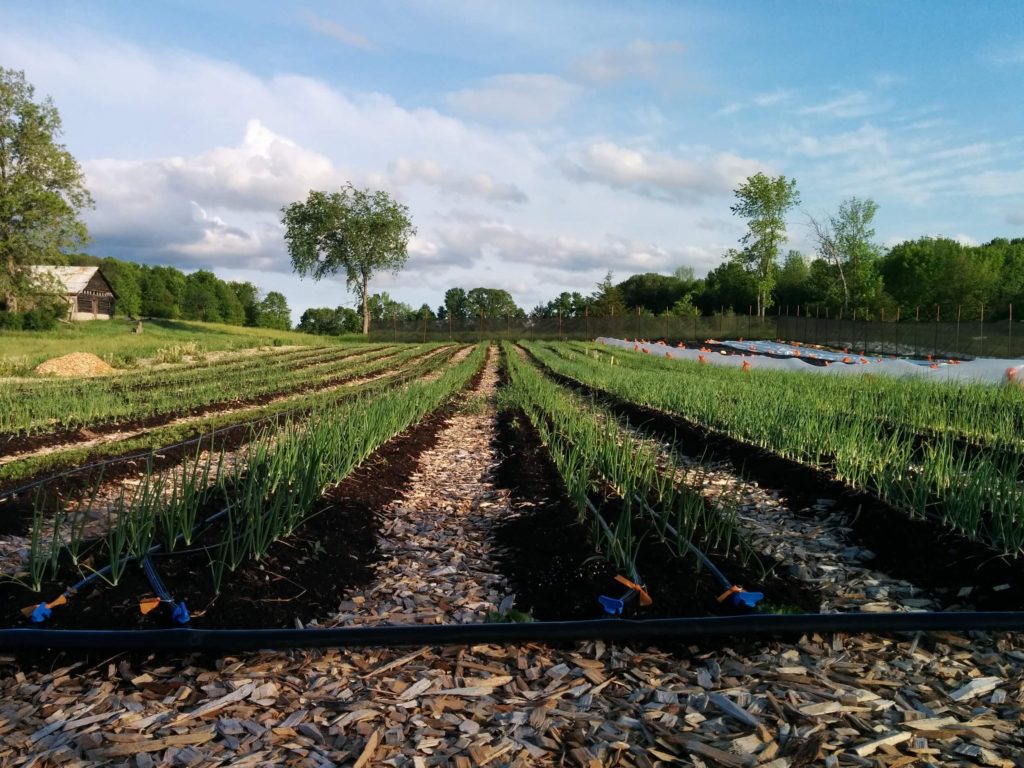

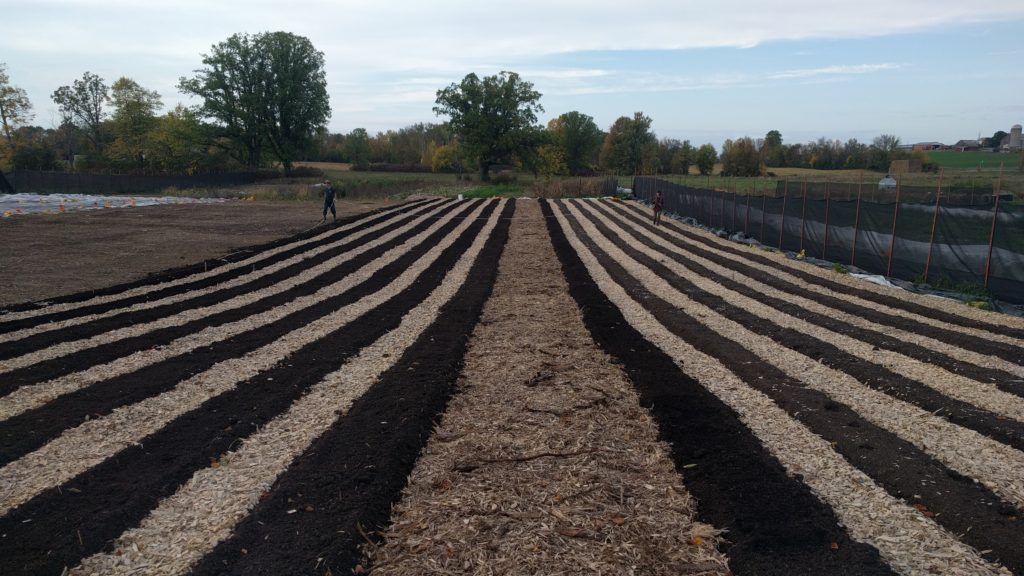
This move to permanent no-dig beds was a huge change. It cost a lot. It added an extra layer of complexity to crop planning during the transition year. And it required a big overhaul of my irrigation system that was originally set up for a wider bed spacing.
I’d been meaning to write a little update explaining the process of transitioning growing systems, but when I thought about why this happened, I realized that I needed to go back further and explain how this farm has evolved in general. And since, over the years, a number of you have asked me to explain how I started farming, and to describe my farming practices in more detail, I thought this whole garden transition would make a nice framework to answer your questions!
So, if you want to know about how I got into farming, as well as (overly-specific) explanations of soil, tillage systems and permanent no-dig beds, all jumbled together, read on!
♦
The thing with market gardening is that many of us owner-operators don’t come from an agricultural or rural background. Maybe we’ve always liked to garden, or grow potted plants. Maybe we idly fantasized about “moving out to the country”, but the seeds (hah) of a “real farm” germinated in the pages of Wendell Berry’s The Unsettling of America, sitting on the edge of a gorgeous backcountry Killarney lake. Or maybe it was after watching a dark and disturbing documentary about Big Ag and the fragility of the globalized food production system. Or maybe we were civil engineering students who came across a very cool farm not from campus and decided to volunteer there. Or maybe we heard the most lovely Americana-folk band wax lyrical about soil and land, and developed an itch that couldn’t be scratched until I (er, we) got our hands into the dirt. And then we went on Youtube and saw video evidence of a new, more sustainable and easier way to farm and make money(!!).
All this to say, I got into farming with very little practical knowledge and a whole lot of strong ideas about how things should be done better. I brought all these visions of lush, nutrient-dense crops bursting out of dark, loamy, fertile soil…and faced a hay field with waist-high grass and at least half a foot of solid root mass underground. How does one turn all this into loose soil that can be planted into? Plowing? But all the inspiring books told me that plowing (tilling) is a Very Bad Thing…
I knew, in theory, how one could do this in a small house garden without tillage – but for my future 1.5 acre market garden? My mind simply could not compute the scaling required to go from that house garden, to the material and labour needed for a farm garden. (Spoiler alert: I did, in fact, use a technique that is more commonly used in house gardens (at least, in North America) to transition the farm to no-dig beds…so I guess my mind DID eventually compute it.) But back to the story.
Cautious and risk-adverse as I was, I went with what I already had. I had a tractor. I had the most lovely and helpful neighbour who offered to plow my field for me. And I got a sweet deal off Kijiji for a disc harrow and chains to break down the plow furrows and create loose soil for planting.
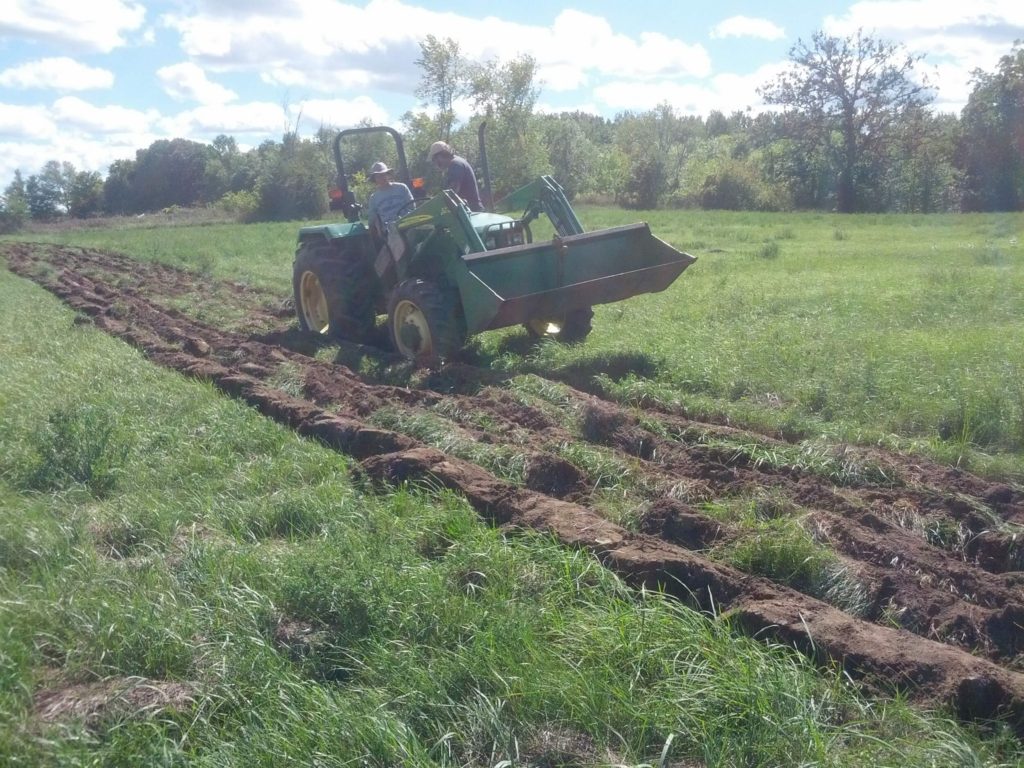
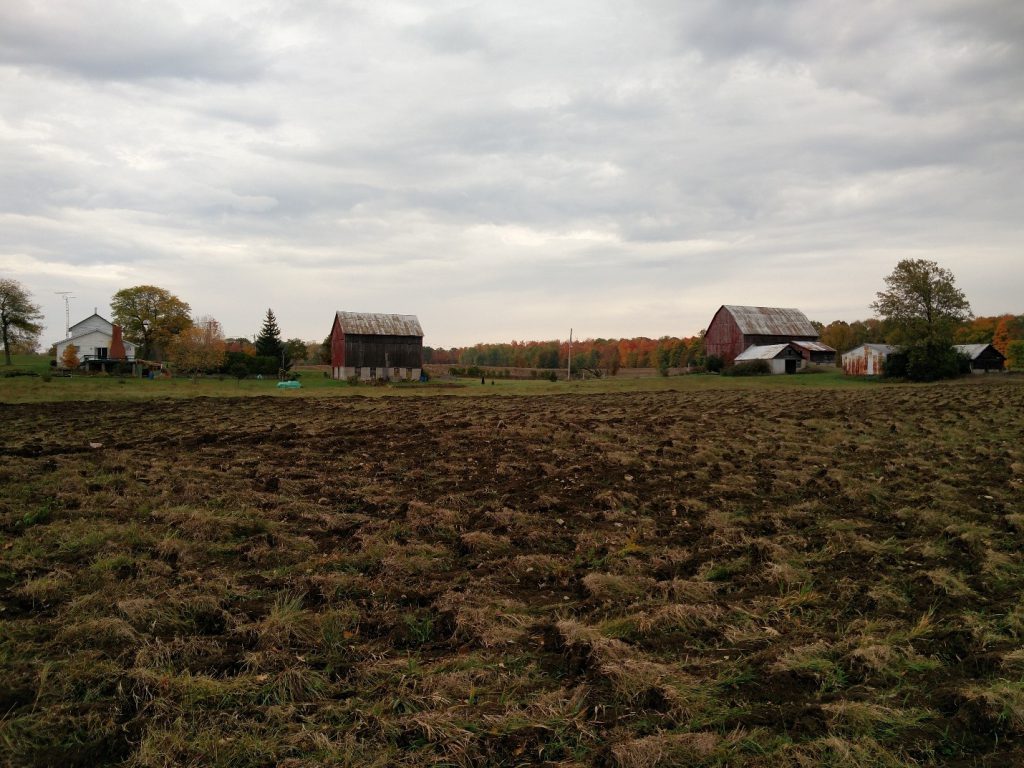
Was this ideal? From a soil health perspective, not exactly. Working the soil with heavy machinery is effective, but it comes with its own costs – the tractor is heavy, the soil gets compacted over time, and especially with heavier soils (like mine), you are constrained by the weather (try working up soil just after a rain with a tractor, and you’re liable to turn your garden into a mud pit of deep ruts and slime). The thing with soil is that we often think of it as material – like sand in a sand box. But really, soil is less a material than a skin. Gross imagery of plowing your own skin apart aside (yep, my mind went there), what you are doing to soil when you plow (or till), is disrupting an architecture and structure. Every square inch of soil is teeming with microscopic life – bacteria, fungi, insects – exchanging nutrients, air and water through pathways they have built up over time. Things are happening. When you jumble it all together so that you can plop down your tomato plants, you are jumbling up infrastructure. Imagine bulldozing a city to the ground, so that you could set your house down onto the rubble. Well… you made space for your house, but you also just ground up the roads, power lines, and water and sewage pipes.
Unfortunately, if I want my vegetable plants to thrive, some amount of soil disturbance is inevitable – especially because the plants that I want to grow are bred for deliciousness (e.g. delicate, crisp and sweet lettuce), and not for survivability (e.g. bitter and tough wild lettuce).
In a more general sense, when I look at an “empty” field (teeming with life, food and function – just not for the modern human) and say “I want to use this place to produce food that humans can eat”, the intention behind this desire cannot be without disruption and occupation of an already existing ecosystem. The implications of occupying space as a human in this world is something I think about a lot, and it’s partly why I refer to this farm as an “ecological” farm (as opposed to “sustainable” or “no-dig” or “regenerative”) – because one of my ongoing goals for this farm is to find a niche within the surrounding ecological context that fits less like that house on rubble, and more like the way our local red-tailed hawk and the goldenrod fit…But I digress. Back to my newly plowed garden.
♦
There’s a wide spectrum of ways to go about managing a garden that is tilled, and I gravitated toward a system developed by Anne and Eric Nordell of Beech Grove Farm. Soil health and weed-control was accomplished by full year fallow periods for the garden and a carefully curated cover-crop rotation plan.
A fallow period is a period of rest for the ground, where no crops intended for harvest are grown. Cover-crops are crops that are grown, not to be harvested, but to be worked back into the ground to improve the soil in some way (e.g. reduce erosion, add nutrients or organic matter, manage disease, aerate compacted soil structure, etc.).
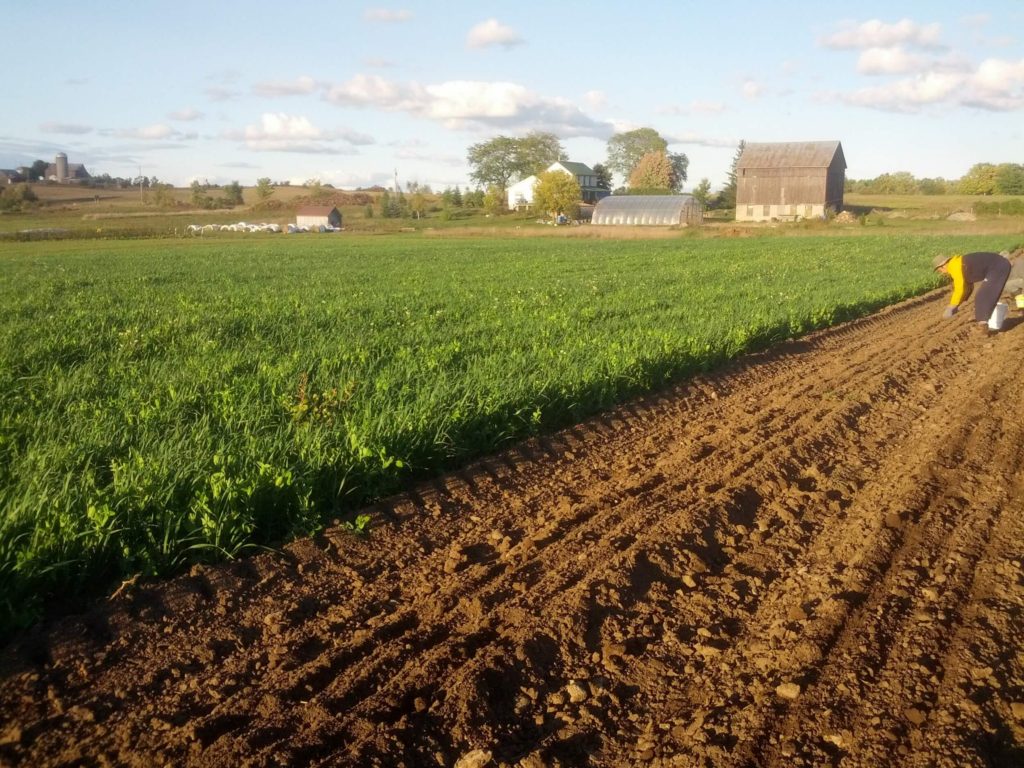
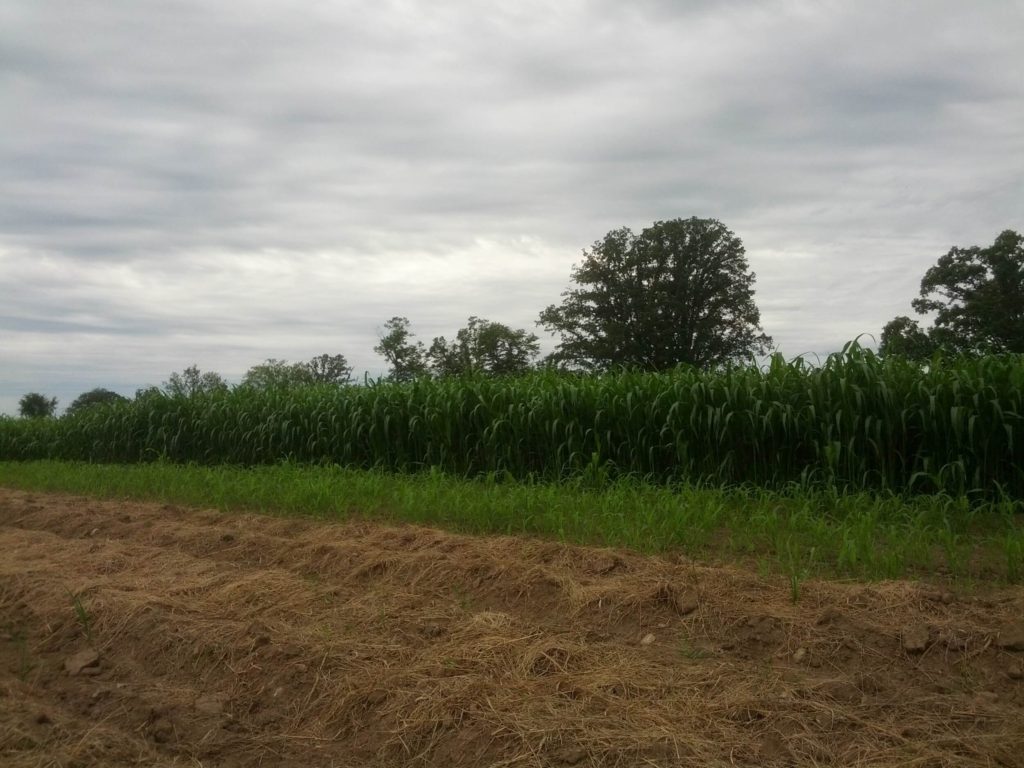
I wasn’t nearly as precise as the Nordells were in their fallow/cover-crop rotation management, but with a few adaptations, their system still worked well in my context. Allowing the garden to rest for a full year did mean managing twice the amount of land I actually needed to grow vegetables (my 1.5 acre vegetable garden required 3 acres of land, so that I could rotate back and forth between 1.5 acre plots). But the long fallow periods were also very forgiving for a new farmer like me – if I let weeds get out of control among my vegetables one year, I wouldn’t have to worry about those weeds impacting the subsequent year’s vegetable crop – because that patch of land would be in fallow the following year (and it’s significantly easier to get rid of weeds on a fallowed plot than when they are interspersed between your carrots!).
♦
Where this system didn’t work as well for me, was when the weather didn’t behave.
Ah yes, the weather.
Farmers always complain about the weather, don’t they? And if there was ever a stereotype for me to fall into, it would be that I think/ponder/contemplate/brood about the weather all the time. I even dream about the weather (I’m not joking – my dreams get realllyyyy boring during the growing season). I check forecasts obsessively. I agonize over greenhouse-destroyable wind speeds and snowpack statistics. I think about cold and hot temperatures as proxy indicators for insect populations (“Today, it is hot enough for aphid reproduction!”). And I probably talk about the weather more often than most people want to hear about it.
Short of cutting off my entire food production system from the outdoors (i.e. grow entirely indoors and use derived sources of energy to produce the artificial lighting, air, growing medium and nutrients that your crops need), the weather will always be a major factor in the success of my growing season. This may sound self-evident, but I think the part that does not get underscored enough is that this is an important factor of success that is not in the grower’s direct control.
Aligning what crop we grow and when we grow them within our specific regional weather and climate contexts is how growers work with the weather. Peppers and tomatoes grow best in the long warm days of the summer, and turnips grow best in the cool spring when flea beetle populations aren’t too low. Growers try and stretch these “ideal” periods by adding environmental buffers. In my case, I use a polytunnel for earlier (and later) tomatoes, and I coax cool-loving crops into the heat of July with additional irrigation and insect barriers (row cover).
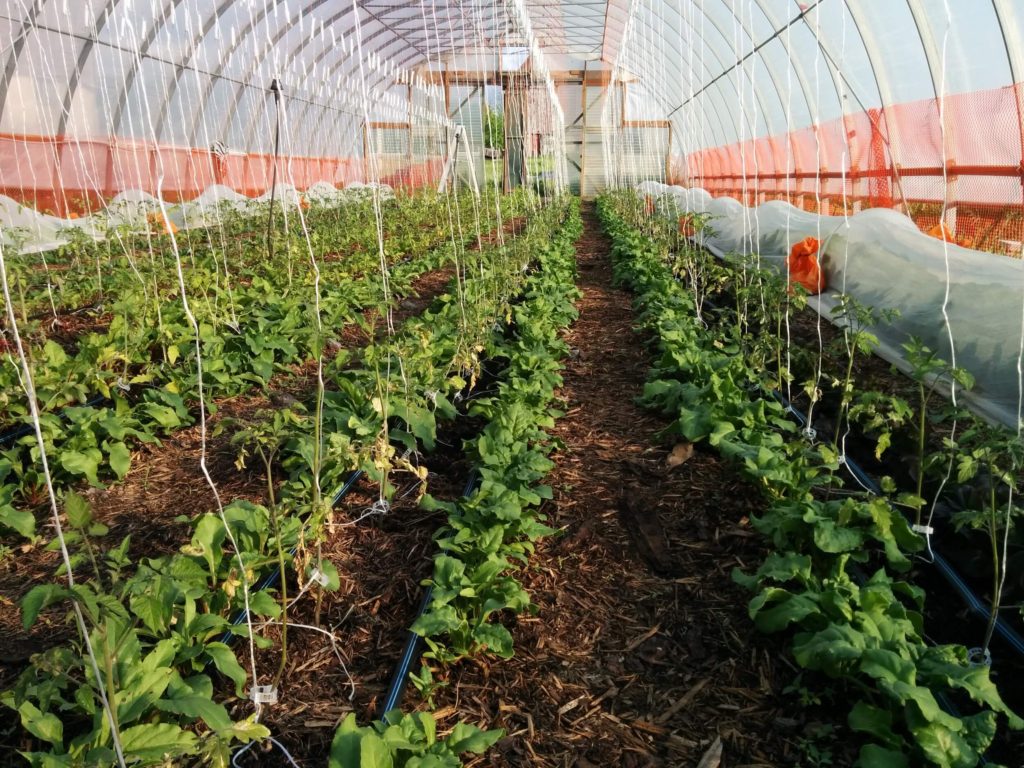
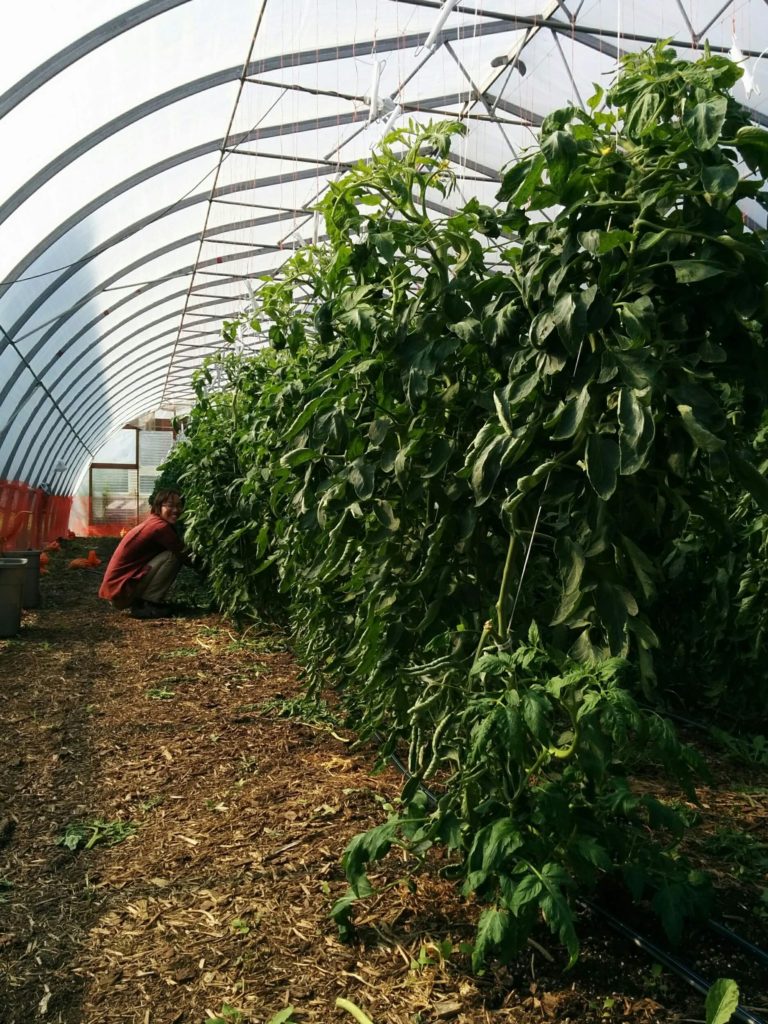
But with each additional environmental buffer, we are expending more energy to grow that crop out of season – the manufacturing energy required for the additional materials (insect barriers, plastic and metal for polytunnels) and the gas or electricity required to run a water pump frequently in the summer to both irrigate and cool crops. As growers, we all draw the line somewhere on the spectrum of environmental buffers and additional energy costs, from those who grow almost entirely without added buffers, to those who heat greenhouses and provide artificial lighting for growing tomatoes in the middle of a Canadian winter.
The thing with working with the weather, is that despite one’s complete lack of control over it, you can generally expect the weather to change with some amount of predictability. In our southern Ontario humid continental climate, we expect there to be four distinct seasons and we expect those four distinct seasons to move into each other with a certain amount of coherence. In the spring, just as I’m ready to plant the first cool-weather crops outside, the ground is drying up just enough that I can get the tractor into the garden to disc and form garden beds. There might be less rainfall in the summer in general, but one little rain is all I need to germinate the drought-hardy sudangrass in my fallowed plot. In the fall, the weather becomes reasonably cold enough in mid-October that I can plant my garlic without worrying that they will prematurely sprout.
If you are a farmer in southeastern Ontario reading this, you might know that this is not how the weather has gone lately. In the last five of this farm’s existence, I have not seen a year without some sort of major heat, cold, flood or drought record being broken. The weather has not only been extreme (hot got hotter, dry got drier, wet got wetter), it has been weird – hot when it should have been cold, cold when it should have been hot. You can argue over the implications of these trends as much as you like, but the last five years of chaotic weather have served as a stress test for the way I farmed – and it was enough for me to notice the weak links.
Take spring planting, for example.
With our short growing season, it is imperative to start planting as early as possible. After all, I only have a limited number of weeks in a year to sell vegetables and make money. With the fallow/cover-crop rotation system, my earliest crops were planted into ground that was previously occupied by an oats and peas cover-crop planted the previous September. This cover-crop added organic matter and fixed nitrogen into the soil throughout the fall. Once killed by the frost, the crop residue on the soil surface and the roots belowground minimized soil erosion over the winter (compared to leaving the soil bare). By spring, the oats and peas would be partially decomposed, and with the tractor, I could break up the remaining crop residue, mix it all back into the soil, and form garden beds to plant my earliest greens and alliums.
If the spring was “normal” (that is, wet and rainy, but with enough sunny days for the soil to dry up and allow the tractor to work), this made for lovely, crumbly soil with a nitrogen and organic matter boost from the oats and peas.
If the spring was abnormally wet and cold (as it was in 2017 and 2019), it made for a delayed start to the planting season, lost revenue from crops late to market, and an awful lot of stressful planting marathons to catch up when the rain finally did recede.
I should note, I don’t think there’s a farmer out there naïve enough to expect the “perfect” average weather every year (or any year, for that matter – that’s not how averages work). But with every extreme weather event, whether it was drought, flood, extreme heat, or unexpected cold, I found more and more points of failure for the farm – enough that I knew I needed to reassess the structure of my garden. When I think of these points of failure for the farm, I like to think of them in “as long as” statements. This farm runs, as long as…
…my body is able to do the physical work (and I remember to stretch my hamstrings regularly)
…my cargo van runs
…I have enough water to irrigate the garden during the longest dry period in the summer
When I thought about my fallow/cover-crop rotation system, I realized that this system works…as long as the weather behaves.
And since well-behaved weather was no longer a given, nor was it something I could control directly, I needed to change my growing system. (Did I just explain that I’m changing growing systems because of the implications and uncertainties of a changing climate and weather patterns, but in a very roundabout way? Yep.)
♦
Moving toward some form of growing system that didn’t require working the soil was a logical step to deal with weather uncertainties – so many aspects of working the soil, whether by rototiller, disc harrow or plow, relied on good weather. I also wanted to move away from relying on heavy machinery to do that work. Since permanent beds are, well, permanent, they are not usually conducive to big heavy machines driving over them (though I have seen an example of permanent beds worked by tractors). So, the shift to no-dig permanent beds in my context also meant a shift to manual work.
I’ll admit, a small part of me was drawn to the aesthetics of doing the work by hand and with hand tools. And if I had to choose between getting a knee injury from that stiff and heavy tractor clutch, or a hamstring strain from bending over too much to pick weeds by hand, I would take the latter (I’ve experienced both, so I’m not speaking hypothetically here). And I should be clear, aesthetics aside, hand tools did not replace previously mechanized labour. The mechanized labour of working the soil no longer existed in the new system. And with the right hand tools, the manual labour actually got easier. Even with just half of the garden transitioned to no-dig permanent beds in 2021, I saw a significant reduction in the overall amount of work required to grow the same amount of food.
This reduction in work had a lot to do with the particular no-dig system I decided to use – the deep compost mulch method. The key to this system is in its initial heavy application of material – in my case, my beds were formed by a six-inch layer of compost and the pathways by a six-inch layer of woodchips. This thick layer of material stifled out most weeds that are particularly problematic on farms – the annual weeds that require light and oxygen to germinate, or as I think of them, disturbed soil weeds. These are the plants that are first to arrive on the scene, to stabilize the soil after something (like a wild boar – or a farmer!) has disturbed and exposed the ground. Their seeds can sit in the soil for years, only germinating when the soil is disturbed – that is, exposed to light and oxygen. So if the soil was both left undisturbed and buried under a thick layer of compost, very little germination occurs. This huge reduction in time spent weeding was important to me, not because I don’t like weeding, but because of how much time it takes relative to other tasks on the farm. I would much rather spend more time encouraging the growth of the plants I actually want, and less time preventing the growth of plants I don’t want!
Along with weed suppression, the woodchips in the pathways provided better water absorption and retention compared to bare soil, essentially creating a buffer against drought and flood conditions. An unusually wet spring was no longer a big influence on when I could start planting. And where parts of my old garden would be flooded during a large rain event, the woodchips absorbed excess moisture much more readily.
The presence of woody material also encourages the growth of mycorrhizal networks that can enhance the exchange of water, nutrients and minerals. These networks are often not present in gardens because they take a long time to establish (disrupting the soil often through tillage does not help this) and garden soil, in the absence of woody materials, are often more bacterial than fungal. (I spent way too much time last year digging little holes in my pathways to find the tiny white threads of myceliae forming…hopefully, the novelty of this will wear off as these networks become an established presence in the garden!)
♦
While I think that this growing system is a much better fit for the farm, I’m very conscious about how contextual this assertion is – no-dig permanent beds fit the specific context of this particular farm…for now (and hopefully for a while yet!). In all my reading and exploration of various farming methods, what I have learned to appreciate most are the growers who share their growing systems, not as silver bullets or “the most sustainable way to farm”, but as specific methods and approaches adapted to their specific farm. This awareness of context in general, and more specifically, of ecological context, is one step toward building a farm that actually fits into its surrounding world (as opposed to struggling against it). The phrase “working with nature” has unfortunately been co-opted into romanticized notions of the natural world as some garden of Eden, ready to help your mutant vegetable plants thrive, miraculously free of voles, deer, and other veggie-loving animals. But, at its most basic meaning, I think it still stands as a useful piece of wisdom – if only because the idea of “working with” necessitates the ability to observe the natural world, and evolve in response to the changes happening all around.
So there you have it. A brand new growing season with a brand new growing system – we shall see what 2022 brings!